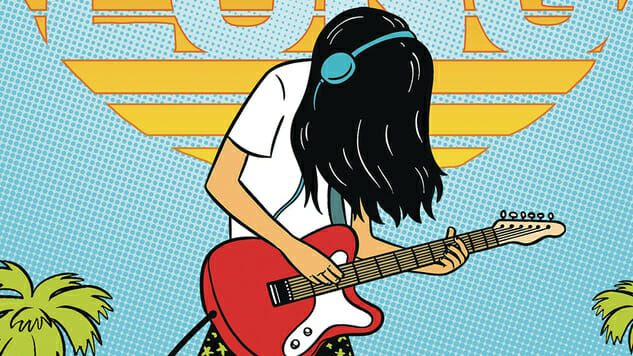All Summer Long’s Hope Larson Talks Music, Inclusiveness & Being a “Big Dork” as a Teenager
Art by Hope Larson
Over the past 10 years, Hope Larson has shifted a bit from being primarily known as an artist to being better known as a writer, but she’s great at both things, and her new book All Summer Long lets her show it. It’s more disciplined than her early work in some ways—or maybe it would be fairer to call it less lyrical—but it has the same gently probing interest in adolescence that is present throughout her career. There’s nothing very dreamy in All Summer Long, her latest preteen-friendly release from publisher Farrar, Straus and Giraux, and that makes it a stronger book. For those unfamiliar, All Summer Long finds protagonist Bina discovering music just as her relationship with longtime friend Austin starts to drift in the wake of puberty and the countless changes that come with turning 13. The lessons in it are subtle (but there!), and the characters feel real. Larson chatted with us over email about the book, the role of music in her life and what made her change paths from drawing to writing.
![]()

All Summer Long Cover Art by Hope Larson
Paste: You go back and forth among writing for other people to draw, drawing other people’s writing and writing and drawing your own stuff. Are there adjustments you have to make when switching from one of those to another, or is it an easy transition?
Hope Larson: Aside from A Wrinkle in Time, which I also scripted, I don’t draw for other people. But, for the most part, it’s an easy transition. I write full script no matter who I’m writing for, meaning that I write out what’s in every panel, on every page, in advance. The main difference from project to project is that if an artist is particularly good at drawing something (environments, hand-to-hand combat, gooshy feelings), I try to play to their strengths.
Paste: Which do you like the most?
Larson: I prefer to write for a trusted collaborator with whom I’ve established a rapport. Drawing myself isn’t something I particularly enjoy, but I do find that process gratifying.
Paste: Did you start out more as a writer or more as an artist? How did your schooling affect where you went from there?
Larson: I was definitely more on the art side starting out. I went to art school. I didn’t study writing or storytelling. I didn’t become confident as a writer until I had good editors to help me through the process; now it’s my favorite part of making a comic.
Paste: So what led you more into writing than drawing? What was the tipping point, basically?
Larson: I burned myself out a bit drawing A Wrinkle in Time, which is 400 pages long, and wanted to switch gears. But ultimately, I enjoy the writing part much more than the drawing part of the process.
Paste: What did you think of the movie version of A Wrinkle in Time?
Larson: I think the team made a lot of smart choices that haven’t been appreciated. It’s a challenging book to adapt and compress, which is why I didn’t compress it at all. If I had to crunch it down to movie length, I have no idea how I’d approach it. I don’t know that I could do any better.
Paste: One of the things I see as recurring in your work is this determination not to take a narrative where most people would (i.e., the idea that Bina and Austin would end up together is made to seem ridiculous). Is that intentional?
Larson: No, it’s not. I’m one of those people who feels that there’s nothing new under the sun, and all the stories have been told, and all you can do is write honestly, in the hopes that it will feel new and resonate with readers. I’m definitely not trying to gotcha anyone. I just do my best to understand the characters and write them making the choices that feel true to them.

All Summer Long Interior Art by Hope Larson & MJ Robinson
Paste: Your heart seems to be with two-color work. Is that accurate? Why or why not?
Larson: It’s a nice compromise between black and white and full color. Cheaper and faster to execute than color; less spare than full color. The coloring in this book was done by MJ Robinson, who did a great job.
-

-

-

-

- Curated Home Page Articles By Test Admin October 21, 2025 | 3:10pm
-

- Curated Home Page Articles By Test Admin October 21, 2025 | 2:57pm
- Urls By Test Admin October 21, 2025 | 2:57pm
- Curated Home Page Articles By Test Admin October 21, 2025 | 2:55pm
-

-

-

-

-

-

-

-

-

-

-

-

-

-

-

-

-

-

-

-

-

-

-

-

-

-

-

-

-

-

-






































